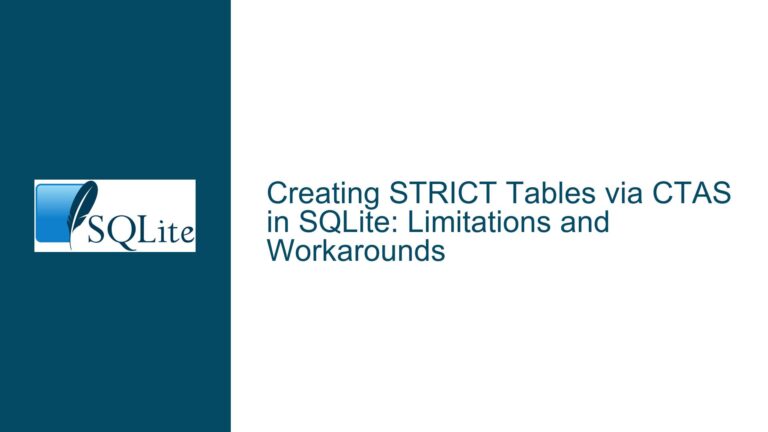Handling Missing “IF NOT EXISTS” for ADD COLUMN in SQLite
SQLite’s Lack of "IF NOT EXISTS" for ADD COLUMN
SQLite is a lightweight, serverless database engine that is widely used in embedded systems, mobile applications, and small-scale projects. One of its limitations is the absence of an "IF NOT EXISTS" clause for the ALTER TABLE ADD COLUMN statement. This means that if you attempt to add a column that already exists, SQLite will throw an error, halting the execution of your script or application. This limitation can be particularly frustrating for developers who are accustomed to other database systems like PostgreSQL, which support this feature.
The absence of this feature in SQLite is not an oversight but rather a design choice. SQLite prioritizes simplicity and performance, and adding such a feature could complicate the database engine’s internal logic. However, this does not mean that developers are left without options. There are several workarounds and best practices that can be employed to achieve the same functionality, albeit with a bit more effort.
The core issue here is that SQLite does not provide a built-in mechanism to conditionally add a column only if it does not already exist. This can lead to errors in applications that dynamically modify their schema, especially in scenarios where the schema might evolve over time. For example, if you are developing an application that needs to add new columns to a table as part of an update, you would need to ensure that the column does not already exist before attempting to add it. Without a straightforward way to do this, developers must resort to alternative methods.
Potential Risks of Dynamic Schema Modifications
Dynamic schema modifications, such as adding columns on the fly, can introduce several risks and complications. One of the primary concerns is the potential for schema corruption. If an application attempts to add a column that already exists, SQLite will throw an error, which could disrupt the application’s flow. This is especially problematic in scenarios where the application is running in a production environment, where errors can have significant consequences.
Another risk is the potential for data inconsistency. If an application dynamically modifies the schema without proper checks, it could lead to situations where the schema does not match the expected structure. For example, if an application assumes that a column exists but it does not, this could lead to runtime errors or incorrect behavior. This is why it is generally recommended to avoid dynamic schema modifications unless absolutely necessary.
Furthermore, dynamic schema modifications can complicate the maintenance and debugging of an application. If the schema is modified on the fly, it can be difficult to track changes and understand the current state of the database. This can make it challenging to diagnose issues or perform upgrades. For these reasons, it is generally advisable to design the schema upfront and avoid making changes to it during runtime.
Workarounds for Conditional Column Addition
Despite the limitations of SQLite, there are several workarounds that can be used to conditionally add a column only if it does not already exist. These workarounds involve using a combination of SQL queries and application logic to check for the existence of a column before attempting to add it. Below, we will explore some of the most common approaches.
Using PRAGMA table_info to Check for Column Existence
One of the most straightforward ways to check for the existence of a column in SQLite is to use the PRAGMA table_info command. This command returns information about the columns in a specified table, including the column name, data type, and whether the column is a primary key. By querying this information, you can determine whether a column exists before attempting to add it.
Here is an example of how you can use PRAGMA table_info to check for the existence of a column:
PRAGMA table_info(mytable);
This command will return a result set with one row for each column in the table mytable. You can then iterate through the result set to check if the column you want to add already exists. If the column does not exist, you can proceed with the ALTER TABLE ADD COLUMN statement.
Using sqlite3_prepare to Check for Column Existence
Another approach is to use the sqlite3_prepare function in the SQLite C API. This function prepares a SQL statement for execution and returns a status code. If the statement is valid, the function will return SQLITE_OK. If the statement is invalid, such as when referencing a non-existent column, the function will return an error code.
Here is an example of how you can use sqlite3_prepare to check for the existence of a column:
int rc = sqlite3_prepare(db, "SELECT newcol FROM mytable", -1, &stmt, NULL);
if (rc == SQLITE_OK) {
// The column exists
sqlite3_finalize(stmt);
} else {
// The column does not exist
// Proceed with ALTER TABLE ADD COLUMN
}
In this example, the sqlite3_prepare function is used to prepare a SELECT statement that references the column newcol. If the column exists, the function will return SQLITE_OK, and you can finalize the statement. If the column does not exist, the function will return an error, and you can proceed with adding the column.
Using sqlite3_table_column_metadata to Check for Column Existence
The sqlite3_table_column_metadata function is another option for checking the existence of a column. This function is part of the SQLite C API and provides metadata about a specific column in a table. If the column exists, the function will return SQLITE_OK. If the column does not exist, the function will return an error.
Here is an example of how you can use sqlite3_table_column_metadata to check for the existence of a column:
int rc = sqlite3_table_column_metadata(db, NULL, "mytable", "newcol", NULL, NULL, NULL, NULL, NULL);
if (rc == SQLITE_OK) {
// The column exists
} else {
// The column does not exist
// Proceed with ALTER TABLE ADD COLUMN
}
In this example, the sqlite3_table_column_metadata function is used to check for the existence of the column newcol in the table mytable. If the column exists, the function will return SQLITE_OK. If the column does not exist, the function will return an error, and you can proceed with adding the column.
Using PRAGMA user_version for Schema Versioning
Another approach to managing schema changes in SQLite is to use the PRAGMA user_version command. This command allows you to store a version number in the database that represents the current schema version. By checking this version number, you can determine whether the schema needs to be updated and apply the necessary changes.
Here is an example of how you can use PRAGMA user_version for schema versioning:
PRAGMA user_version;
This command will return the current schema version stored in the database. You can then compare this version number with the version number expected by your application. If the database version is lower than the expected version, you can apply the necessary schema changes, such as adding new columns.
Here is an example of how you can update the schema version after adding a new column:
PRAGMA user_version = 2;
In this example, the PRAGMA user_version command is used to update the schema version to 2 after adding a new column. This allows you to keep track of the schema version and ensure that the necessary changes are applied.
Using an Application-Specific Schema Table
Another approach to managing schema changes is to create an application-specific schema table that stores information about the current schema version. This table can be used to track changes and ensure that the schema is updated as needed.
Here is an example of how you can create an application-specific schema table:
CREATE TABLE IF NOT EXISTS appschema (
version INTEGER PRIMARY KEY
);
In this example, the appschema table is created to store the current schema version. You can then use this table to check the schema version and apply the necessary changes.
Here is an example of how you can update the schema version after adding a new column:
INSERT INTO appschema (version) VALUES (2);
In this example, the appschema table is updated to reflect the new schema version after adding a new column. This allows you to keep track of the schema version and ensure that the necessary changes are applied.
Using Deep Schema Introspection
For more complex scenarios, you can use deep schema introspection to examine the structure of the database and determine whether a column exists. This involves querying the sqlite_master table, which contains information about the database schema, including tables, columns, and indexes.
Here is an example of how you can use deep schema introspection to check for the existence of a column:
SELECT sql FROM sqlite_master WHERE type = 'table' AND name = 'mytable';
This query will return the SQL statement that was used to create the table mytable. You can then parse this statement to determine whether the column newcol exists. If the column does not exist, you can proceed with the ALTER TABLE ADD COLUMN statement.
Best Practices for Schema Management
While the above workarounds can be used to conditionally add columns in SQLite, it is important to follow best practices for schema management to avoid potential issues. Here are some recommendations:
Design the Schema Upfront: Whenever possible, design the schema upfront and avoid making changes to it during runtime. This will help you avoid potential issues and make it easier to maintain the database.
Use Schema Versioning: Use schema versioning to track changes and ensure that the schema is updated as needed. This can be done using the
PRAGMA user_versioncommand or an application-specific schema table.Avoid Dynamic Schema Modifications: Avoid making dynamic schema modifications unless absolutely necessary. If you need to modify the schema, do so in a controlled manner and ensure that the changes are properly tested.
Use Transactions: When making schema changes, use transactions to ensure that the changes are applied atomically. This will help you avoid potential issues in case of errors or interruptions.
Backup the Database: Before making any schema changes, backup the database to ensure that you can recover in case of issues. This is especially important in production environments.
Test Changes Thoroughly: Test schema changes thoroughly before deploying them to production. This will help you identify and resolve any potential issues before they affect users.
By following these best practices, you can ensure that your schema is well-managed and that your application runs smoothly.
Conclusion
While SQLite does not provide a built-in "IF NOT EXISTS" clause for the ALTER TABLE ADD COLUMN statement, there are several workarounds that can be used to achieve the same functionality. These workarounds involve using a combination of SQL queries and application logic to check for the existence of a column before attempting to add it. By following best practices for schema management, you can ensure that your schema is well-maintained and that your application runs smoothly. Whether you choose to use PRAGMA table_info, sqlite3_prepare, sqlite3_table_column_metadata, or deep schema introspection, the key is to approach schema changes with caution and ensure that they are properly tested and managed.






